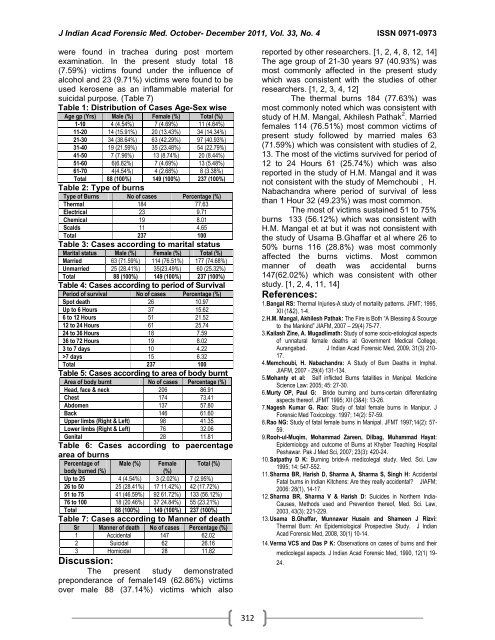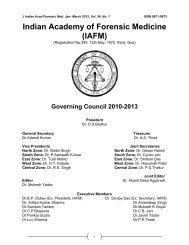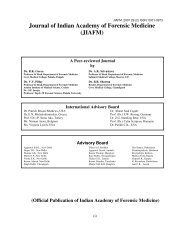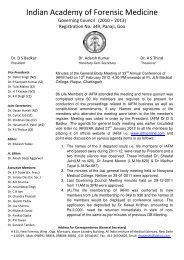Indian Academy of Forensic Medicine (IAFM) - Official website of IAFM
Indian Academy of Forensic Medicine (IAFM) - Official website of IAFM
Indian Academy of Forensic Medicine (IAFM) - Official website of IAFM
Create successful ePaper yourself
Turn your PDF publications into a flip-book with our unique Google optimized e-Paper software.
J <strong>Indian</strong> Acad <strong>Forensic</strong> Med. October- December 2011, Vol. 33, No. 4 ISSN 0971-0973<br />
were found in trachea during post mortem<br />
examination. In the present study total 18<br />
(7.59%) victims found under the influence <strong>of</strong><br />
alcohol and 23 (9.71%) victims were found to be<br />
used kerosene as an inflammable material for<br />
suicidal purpose. (Table 7)<br />
Table 1: Distribution <strong>of</strong> Cases Age-Sex wise<br />
Age gp (Yrs) Male (%) Female (%) Total (%)<br />
1-10 4 (4.54%) 7 (4.69%) 11 (4.64%)<br />
11-20 14 (15.91%) 20 (13.43%) 34 (14.34%)<br />
21-30 34 (38.64%) 63 (42.29%) 97 (40.93%)<br />
31-40 19 (21.59%) 35 (23.48%) 54 (22.79%)<br />
41-50 7 (7.96%) 13 (8.74%) 20 (8.44%)<br />
51-60 6(6.82%) 7 (4.69%) 13 (5.48%)<br />
61-70 4(4.54%) 4 (2.68%) 8 (3.38%)<br />
Total 88 (100%) 149 (100%) 237 (100%)<br />
Table 2: Type <strong>of</strong> burns<br />
Type <strong>of</strong> Burns No <strong>of</strong> cases Percentage (%)<br />
Thermal 184 77.63<br />
Electrical 23 9.71<br />
Chemical 19 8.01<br />
Scalds 11 4.65<br />
Total 237 100<br />
Table 3: Cases according to marital status<br />
Marital status Male (%) Female (%) Total (%)<br />
Married 63 (71.59%) 114 (76.51%) 177 (74.68%)<br />
Unmarried 25 (28.41%) 35(23.49%) 60 (25.32%)<br />
Total 88 (100%) 149 (100%) 237 (100%)<br />
Table 4: Cases according to period <strong>of</strong> Survival<br />
Period <strong>of</strong> survival No <strong>of</strong> cases Percentage (%)<br />
Spot death 26 10.97<br />
Up to 6 Hours 37 15.62<br />
6 to 12 Hours 51 21.52<br />
12 to 24 Hours 61 25.74<br />
24 to 36 Hours 18 7.59<br />
36 to 72 Hours 19 8.02<br />
3 to 7 days 10 4.22<br />
>7 days 15 6.32<br />
Total 237 100<br />
Table 5: Cases according to area <strong>of</strong> body burnt<br />
Area <strong>of</strong> body burnt No <strong>of</strong> cases Percentage (%)<br />
Head, face & neck 206 86.91<br />
Chest 174 73.41<br />
Abdomen 137 57.80<br />
Back 146 61.60<br />
Upper limbs (Right & Left) 98 41.35<br />
Lower limbs (Right & Left) 76 32.06<br />
Genital 28 11.81<br />
Table 6: Cases according to paercentage<br />
area <strong>of</strong> burns<br />
Percentage <strong>of</strong> Male (%) Female Total (%)<br />
body burned (%)<br />
Up to 25 4 (4.54%) 3 (2.02%) 7 (2.95%)<br />
26 to 50 25 (28.41%) 17 11.42%) 42 (17.72%)<br />
51 to 75 41 (46.59%) 92 61.72%) 133 (56.12%)<br />
76 to 100 18 (20.46%) 37 24.84%) 55 (23.21%)<br />
Total 88 (100%) 149 (100%) 237 (100%)<br />
Table 7: Cases according to Manner <strong>of</strong> death<br />
Sr Manner <strong>of</strong> death No <strong>of</strong> cases Percentage (%)<br />
1 Accidental 147 62.02<br />
2 Suicidal 62 26.16<br />
3 Homicidal 28 11.82<br />
Discussion:<br />
The present study demonstrated<br />
preponderance <strong>of</strong> female149 (62.86%) victims<br />
over male 88 (37.14%) victims which also<br />
(%)<br />
312<br />
reported by other researchers. [1, 2, 4, 8, 12, 14]<br />
The age group <strong>of</strong> 21-30 years 97 (40.93%) was<br />
most commonly affected in the present study<br />
which was consistent with the studies <strong>of</strong> other<br />
researchers. [1, 2, 3, 4, 12]<br />
The thermal burns 184 (77.63%) was<br />
most commonly noted which was consistent with<br />
study <strong>of</strong> H.M. Mangal, Akhilesh Pathak 2 . Married<br />
females 114 (76.51%) most common victims <strong>of</strong><br />
present study followed by married males 63<br />
(71.59%) which was consistent with studies <strong>of</strong> 2,<br />
13. The most <strong>of</strong> the victims survived for period <strong>of</strong><br />
12 to 24 Hours 61 (25.74%) which was also<br />
reported in the study <strong>of</strong> H.M. Mangal and it was<br />
not consistent with the study <strong>of</strong> Memchoubi , H.<br />
Nabachandra where period <strong>of</strong> survival <strong>of</strong> less<br />
than 1 Hour 32 (49.23%) was most common.<br />
The most <strong>of</strong> victims sustained 51 to 75%<br />
burns 133 (56.12%) which was consistent with<br />
H.M. Mangal et at but it was not consistent with<br />
the study <strong>of</strong> Usama B.Ghaffar et al where 26 to<br />
50% burns 116 (28.8%) was most commonly<br />
affected the burns victims. Most common<br />
manner <strong>of</strong> death was accidental burns<br />
147(62.02%) which was consistent with other<br />
study. [1, 2, 4, 11, 14]<br />
References:<br />
1. Bangal RS: Thermal Injuries-A study <strong>of</strong> mortality patterns. JFMT; 1995,<br />
XII (1&2), 1-4.<br />
2. H.M. Mangal, Akhilesh Pathak: The Fire is Both “A Blessing & Scourge<br />
to the Mankind” J<strong>IAFM</strong>, 2007 – 29(4) 75-77.<br />
3. Kailash Zine, A. Mugadlimath: Study <strong>of</strong> some socio-etiological aspects<br />
<strong>of</strong> unnatural female deaths at Government Medical College,<br />
Aurangabad. J <strong>Indian</strong> Acad <strong>Forensic</strong> Med, 2009, 31(3) 210-<br />
17.<br />
4. Memchoubi, H. Nabachandra: A Study <strong>of</strong> Burn Deaths in Imphal.<br />
J<strong>IAFM</strong>, 2007 - 29(4) 131-134.<br />
5. Mohanty et al: Self inflicted Burns fatalities in Manipal. <strong>Medicine</strong><br />
Science Law: 2005; 45: 27-30.<br />
6. Murty OP, Paul G: Bride burning and burns-certain differentiating<br />
aspects there<strong>of</strong>. JFMT 1995; XII (3&4): 13-26.<br />
7. Nagesh Kumar G. Rao: Study <strong>of</strong> fatal female burns in Manipur. J<br />
<strong>Forensic</strong> Med Toxicology. 1997; 14(2): 57-59.<br />
8. Rao NG: Study <strong>of</strong> fatal female burns in Manipal. JFMT 1997;14(2): 57-<br />
59.<br />
9. Rooh-ul-Muqim, Mohammad Zareen, Dilbag, Muhammad Hayat:<br />
Epidemiology and outcome <strong>of</strong> Burns at Khyber Teaching Hospital<br />
Peshawar. Pak J Med Sci, 2007; 23(3): 420-24.<br />
10. Satpathy D K: Burning bride-A medicolegal study. Med. Sci. Law<br />
1995; 14: 547-552.<br />
11. Sharma BR, Harish D, Sharma A, Sharma S, Singh H: Accidental<br />
Fatal burns in <strong>Indian</strong> Kitchens: Are they really accidental? J<strong>IAFM</strong>;<br />
2006: 28(1), 14-17.<br />
12. Sharma BR, Sharma V & Harish D: Suicides in Northern India-<br />
Causes, Methods used and Prevention there<strong>of</strong>, Med. Sci. Law,<br />
2003, 43(3); 221-229.<br />
13. Usama B.Ghaffar, Munnawar Husain and Shameen J Rizvi:<br />
Thermal Burn: An Epidemiological Prospective Study. J <strong>Indian</strong><br />
Acad <strong>Forensic</strong> Med, 2008, 30(1) 10-14.<br />
14. Verma VCS and Das P K: Observations on cases <strong>of</strong> burns and their<br />
medicolegal aspects. J <strong>Indian</strong> Acad <strong>Forensic</strong> Med, 1990, 12(1) 19-<br />
24.









